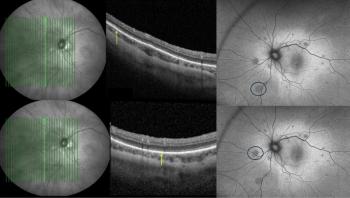
Exploring robotic fractionated radiotherapy for benign ocular tumours
The investigators set out to study if treatment of the tumours close to the optical pathway is safe and whether it may impair a patient’s vision.
Polish investigators led by Dr Michal Orski, PhD, Department of Ophthalmology, Ludwik Rydygier Memorial Specialized Hospital, Krakow, Poland, reported that fractionated robotic radiotherapy of the tumours applied near the optical pathway is safe and does not impact vision despite minor changes in the anatomy of the optic nerve.1
Dr Orski and colleagues undertook a prospective observational study of patients who had been irradiated using the CyberKnife system (Multiplan 4.6 Accuray, Sunnyvale, California, USA) to treat benign tumours.
Patients had a variety of pathologies that included 10 with cavernous sinus meningioma, 9 with pituitary adenoma, 5 with meningioma of the anterior and middle cranial fossa, 5 with meningioma in the region close to optic chiasm, 3 with craniopharyngioma, and 2 with orbital meningioma, the authors described.
All patients received 3 fractions in doses from 600 to 800 centigray. The investigators used the pre-treatment baseline as the control follow-up examinations after radiotherapy. They then assessed the impact of the radiation on the eye based on anatomic and functional changes.
The anatomic features that were evaluated where the ocular surface, central corneal thickness (CCT), endothelial cell density (ECD), lens densitometry, central macular thickness (CMT), and retinal nerve fiber layer (RNFL); the functional features evaluated were the best-corrected visual acuity (BCVA), intraocular pressure (IOP), visual field (VF), and visual-evoked potentials (VEP).
Patients underwent ophthalmologic examinations before radiotherapy and 6, 12, 18, and 24 months after radiotherapy.
“We did not observe any significant changes in BCVA, IOP, CCT, CMT, VF, VEP, and slit-lamp examination during the 2-year observation,” the authors reported.
They did see significant decreases in the ECD and RNFL at all of the evaluations. The decrease in the cell density did not impact the corneal function and vision; the decrease in the RNFL did not impair visual function, they pointed out.
The investigators concluded, “Fractionated robotic radiotherapy of the tumours close to the optical pathway is safe and does not impair patient’s vision. Minor changes found in optic nerve anatomy (RNFL thinning) might be related to the radiation effect or tumour compression. The causal relation between low doses of radiation delivered to the cornea and the observed significant but slight decrease in ECD is uncertain. The observed changes did not cause visual disturbances perceivable by the patients.”
Reference
Orski M, Tarnawski R, Wylegala E, Tarnawski D. The impact of robotic fractionated radiotherapy for benign tumors of parasellar region on the eye structure and function. J Clin Med. 2023;12:404;
https://doi.org/10.3390/jcm12020404
Newsletter
Get the essential updates shaping the future of pharma manufacturing and compliance—subscribe today to Pharmaceutical Technology and never miss a breakthrough.













































